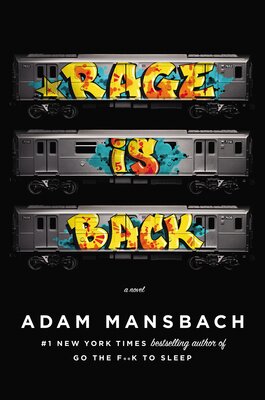 Author Adam Mansbach talks with John Roderick tonight at Town Hall, 7:30 p.m.
Author Adam Mansbach talks with John Roderick tonight at Town Hall, 7:30 p.m.
Adam Mansbach says that, at least in part, his new novel resuscitating the heyday of New York subway graffiti, Rage is Back, is a kind of offshoot from the Bolaño tree — remarking on the Chilean writer’s predilection for stories about the aftermath of youthful, idealistic revolutions. It also comes with a mixtape.
It’s fascinating, in that respect, to gauge the relative success or failure of Mansbach’s attempt to rehabilitate the graffiti artists of mid-’80s NYC, you know, the authentic ones:
Don’t ever mention Haring to a graffiti writer, by the way, or Basquiat either. Not unless you’re ready for a tutorial about how those guys were chumps, never hit trains, didn’t hang out at the Writers’ Bench on 149th and Grand Concourse, only painted where it was safe, fronted like they were real heads and made millions while the real heads are real broke heads, some of them with real broke heads.
That last is courtesy of one Kilroy Dondi Vance, who narrates for you the way his life changed when he — a simple, biracial, expelled-for-selling-pot prep school senior — discovers that his graffiti-legend father, Billy Rage, has reappeared after skipping town in 1989. A substantial amount of the story, then, is told in flashbacks, as Dondi (having first given the reader the official, thumbnail version of what went down) fills in the missing details.
Because Dondi is a stoner raconteur, a substantial amount of what is not the story gets told as well. There’s a game he used to play in sixth grade, inventing “doofus superheroes” like “The Salamanderer, who has the regenerative powers of an amphibian: if you cut off his arm, it grows back, weaker and smaller, in about six weeks.” There’s that Uptown Girl he used to date. There’s the group of sketchy roommates he had as a kid and the big argument over rent.
There’s a consistent meta-discourse on how he’s choosing to write the book you’re reading. (He apologizes for the length of the flashbacks, and explains why he’s not using footnotes.) He has a theory about the rise of the montage:
During the eighties, everybody making moves had mad coke and no patience, so they conveyed the passage of time — a boxer training, a romance blossoming, a teenaged werewolf partying — by splicing together a bunch of four-second scenes denoting incremental progress and setting them to peppy power pop. Like the decade’s other defining concepts — greed, crack, arms for hostages, the religious right, new jack swing — it was crude and tasteless, but effective.
This is clever and funny, but it doesn’t sound like an 18-year-old. It sounds like Adam Mansbach, cultural critic, getting a word in. At nearly 300 pages, and also including a 24-hour time machine, an extended Amazon shamanic training freak-out, and a drug feud, the novel can feel like you keep stepping onto the wrong subway train, when all you want to do is get from A to B.
Between A and B lies the spine of the plot, which is that Billy Rage’s return has aroused the ire of former vandal squad jackbooted thug Anastacio Bracken, who in 2005 is running for mayor. This prompts the reunion of the Immortal Five gang of graffiti artists — actually four, since Bracken had a hand in the death of a fifth member, back in the day. The Immortal Four hatch a plan to discredit Bracken while celebrating the power of the pen.
It all begins to sound a bit goofy — adults who have hit upon the same strategy for civic discourse they used when they were 16 can appear that way — but it gives Mansbach the opportunity to let you tag along on a pulse-pounding night out, so you can feel what it was all about. Here’s Dondi watching his father throw down:
The letter E, nasty as fuck, ready to scrap. And this was just a straight-letter. No bar, no bits, no arrows, legible even to the squarest civilian. Its attitude was a matter of minutiae, of math.
“See? Now a few highlights.”
He switched cans and doubled the inside curves in white, the line emerging thin and sharp. Shifted a few paces to the left, and embarked on his S.
Try to read at least part of the book late at night, when the graffiti artists do their work. I don’t know if Rage is Back will change anyone’s mind about the use and abuse of the public canvas, but it does impress to see artists create their own license in taking risks, as foolhardy as they may be. Thankfully, here in Seattle, we have the abandoned Tubs, now an ever-changing graffiti cathedral.


